Replacing Bathroom Tubes: A Step-by-Step Guide to Work
Dismantling and installation of new communications is an integral part of any overhaul. Typically, the replacement of pipes in the bathroom is carried out by plumbers of the management company. True, you can do the dismantling of old and installing new elements with your own hands, if you know how it is performed. Do you agree?
We will tell you how to repair the pipeline by replacing hazardous areas. In our article, we describe steps to remove worn pipes and how to attach new ones. Based on our advice, you can restore the integrity of a fail-safe system.
The content of the article:
Choosing pipes for the bathroom
Before performing work on replacing communications in the bathroom, it is important to decide which structural elements to give preference to when laying a new system.
For wiring, as a rule, pipes of the following types are used:
- plastic;
- steel;
- cast iron;
- metal-plastic;
- ceramic;
- copper;
- asbestos-cement.
Steel alloy pipes (they contain a variety of additives, aluminum, honey, nickel) are usually used in multi-storey buildings where it is necessary to create an effective and durable wiring.
Such communications are resistant to hot / cold water, withstand high pressure. Among the shortcomings are possible blockages from mineral deposits, which often accumulate on the walls.
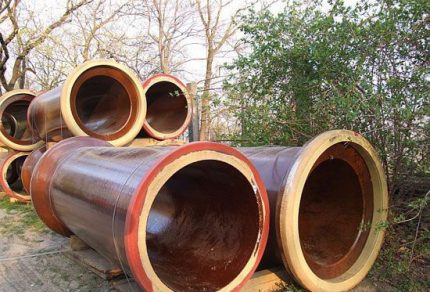
Copper pipes are high-quality durable products that are not susceptible to corrosion and aggressive effects of chemicals.It is worth considering that such elements are expensive and poorly compatible with steel and other metals. Because of these shortcomings, they are most often used in private homes.
In old buildings built in the 60-70s of the last century, cast-iron pipes were usually used. Such systems have important advantages, since this metal has a good heat capacity and resistance to temperature extremes.
A significant disadvantage of such structures is their severity (special equipment is required for installation and analysis), as well as intolerance to shock loads and a tendency to blockages - accumulations of mineral deposits and debris easily form on their surface.
Currently widespread polypropylene pipeswhich differ in reasonable price, ease, elasticity, resistance to corrosion and aggressive substances, not prone to the formation of congestion.

However, their use is justified only for laying intra-house communications, since plastic does not tolerate temperature extremes. In addition, polypropylene pipes are deformed under the influence of high temperatures, so they should be used with caution for hot water supply.
Another material currently popular is metal plasticcombining polymer and metal layers. Such a material weighs slightly more than its plastic counterparts, but it is durable, resistant to mineral deposits, and most importantly, it has an extremely low deformation rate.
As a rule, the latter two options are used for independent work, since polymer and metal-plastic pipes are easy to process and install. Moreover, all work with them can be done with a minimum of special equipment.
When choosing material for replacing communications, it is also necessary to determine the dimensional parameters of the elements:
- pipes with a diameter of 40 mm are suitable for internal risers;
- for sewer discharge - 50 mm;
- for laying hot / cold water systems - 15, 25 and 32 mm.
The process of replacing pipes in the bathroom consists of dismantling the existing water and sewer systems and laying new structural elements.
Compare specifications PP and plastic pipes an article that is fully devoted to assessing the positive and negative sides of the demanded market positions will help.
What materials and tools will be required?
The first step is to prepare the equipment and materials that will be required for the work:
- a grinder with a metal disc for cutting old pipes and fittings;
- manual screwdriver whose diameter must match the size of the material (usually this figure is one inch). Instead, you can use another device designed for threading on metal pipes located in the above- and underlying apartments;
- a punch (preferably percussion type), which will be needed for drilling holes for fasteners, as well as for laying pipes through walls;
- a pipe cutter or a special cutter that allows you to cut sections of the required length from the pipes;
- electric soldering iron with nozzles for mounting the system;
- adjustable wrench;
- technical petroleum jelly, tape FUM;
- hammer;
- screwdriver;
- chisel;
- marker and tape measure, which will be needed for dimensioning.
It is also necessary to stock up on materials, having calculated their stock in advance. To accurately determine the quantity, it is better to draw a communication plan. It is advisable to add a small margin for unforeseen circumstances to the resulting result.
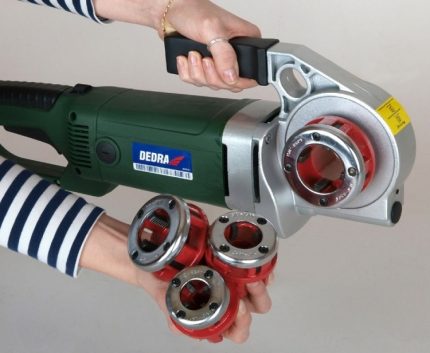
For a standard bathroom you will need:
- pipes with a diameter of 25-32 mm; for the installation of the system there are enough elements, the total length of which will be 20-30 m;
- end and corner fittings (15-20 pieces of each type);
- stopcocks for each node;
- wall mounts;
- two adapters from metal pipes to plastic.
In addition, self-tapping screws, tees and other elements may be needed.
Choosing a pipe system
There are many ways to install a pipeline. The system can be open when the networks are laid directly on the walls. In this case, access to the pipes is facilitated, but the appearance spoils the interior of the bathroom.
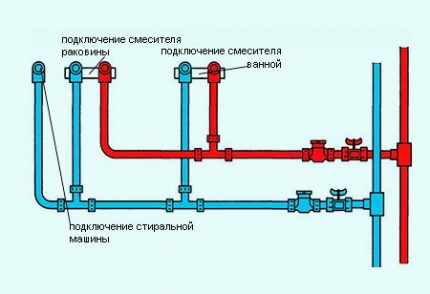
The option with closed communications looks more aesthetically pleasing. In this case, the gates are made in the walls - special grooves where structural elements are hidden, which are then repaired with plaster and finishing materials.
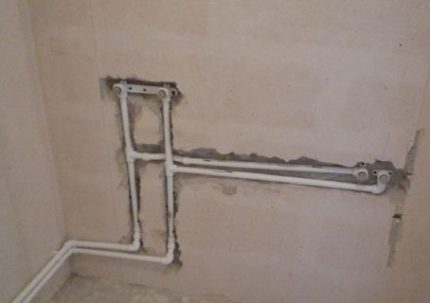
Currently, for laying pipes, they often use the masking method, which does not require special hassle. In this case, when laying structures, they are hidden under plumbing fixtures, interior items or hidden in boxes specially constructed to protect and decorate communications.
Organizational issue when replacing the riser
Installation of new equipment is not possible without dismantling the old. In this case, the difficulty raises the question of replacing the riser in the bathroom, since it affects the neighbors above and below.
It is not enough to change a piece of pipe in one apartment, it is also important to perform work in the ceilings, where there are also structural elements. They are fraught with a considerable threat: cement damages pipes over time, because of which leaks are possible, which are rather difficult to identify and eliminate.
To resolve the issue with neighbors, you can do the following:
- Take written confirmation from the neighbors below that in the event of a leak in the old riser, they will not make claims. For residents living on top, try to sign a document on guarantees of payment for possible damage caused by a rush of old communications. Very often this approach brings its results, and the neighbors agree to joint repair work.
- You can contact the Housing Office with a proposal to make full payment for the replacement of the riser. In this case, the mission of persuading the intractable neighbors is assigned to the representatives of the management company.
It should be remembered that even in a privatized apartment, all the central communications located in it belong to utilities.
Dismantling the old pipeline
The initial stage of work is the removal of all communications in the room. To conduct it, it is necessary to turn off the water supply at the risers, and when replacing it, the water supply in the basement.
In this case, the following rules must be observed:
- To coordinate the planned work with the organization that is engaged in the maintenance of intra-house water supply systems.
- Be sure to inform the residents living in apartments above and below about the upcoming replacement of communications, informing about the exact date and time of work.
- Take all measures for the rapid completion of repairs to ensure timely inclusion of water.
After turning off the water, you can start dismantling, which is carried out in several stages.
Stage 1: trimming and pipe removal
Having received the consent of the neighbors, you need to turn off the water in the riser, and then drain the remaining liquid in them. Then you can proceed to trimming the old pipes with a grinder. In this case, 0.5 m from the floor / ceiling of adjacent apartments should be retreated to facilitate the process of connecting pipes.
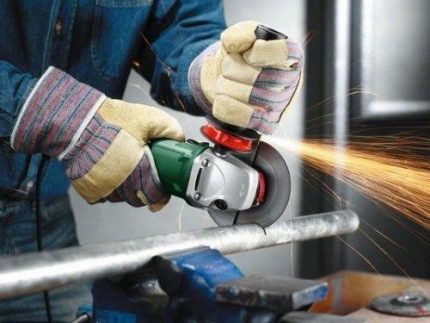
The pipe section located in the plate is loosened by transverse impacts with a hammer, after which it is knocked out (you can also use a chisel or perforator). To dispose of old metal pipes, they can be cut into small elements that are removed or scrapped.
Stage 2: replacing stopcocks and draining water
To replace the shut-off valves at the inlet, the old models are screwed up or cut off by the grinder from the input pipe, after which they are threading with a screwdriver or other device, then new equipment is screwed on. The bolted inlet taps are closed, after which you can turn on the water in the riser.
Water is drained from old pipes so that it does not interfere with further dismantling. A washing machine, faucets, and other water-consuming appliances are disconnected from communications. Similarly, all plumbing products connected to the sewer are disconnected.
Stage 3: removing the dowels and laying the gate
Previously, when installing pipes in the bathroom for wall mounting, dowels were widely used, driven into concrete with a gun.
Since it is extremely difficult to remove such elements, you can remove their heads with a grinder. In this case, an even surface of the walls is created, so that you can safely lay tiles or other finishing material.
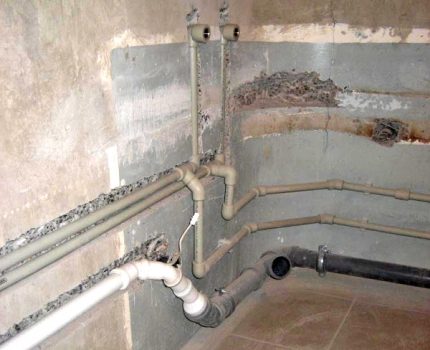
If it is necessary to lay channels in the walls (gating), the metal disc inserted into the grinder should be replaced with a similar part intended for work on concrete, brick and stone. If reinforcement is found in the wall, it is again exchanged for a metal disk.
Installation of communications in the bathroom
After dismantling and gating the walls, you can proceed to laying new pipes. However, before this process, you should make sure once again whether everything is taken into account in the prepared drawing, whether additional materials are required to be purchased.
Pipe replacement work consists of several steps:
- installation of the riser and water distribution;
- installation of sewer networks;
- testing.
Following technological instructions, all manipulations can be performed quite quickly.
Installation of the riser and wiring
Before starting work, make sure that the inner diameter of the new pipes for riser and wiring matches the old one. After that, you can do the process.
How to replace the riser?
Initially follows replace the riser itselfconsidering the subsequent piping routing. For this, it is necessary to determine at what distance from the riser the internal wiring elements will depart, and then cut the pipe prepared for the riser into parts corresponding to the calculation.
Old parts of risers located in adjacent apartments are thread-cut with a screwdriver. After that, adapter flanges are installed on the risers, then these elements are assembled from polypropylene pipes by soldering. Threaded connections are sealed with a tape “Fum”. This order is suitable for metal / plastic joints.
A small section of pipe with a diameter of 0.5 inches is soldered to the outlet flange, at the end of which there is a ball valve installed in the closed position.
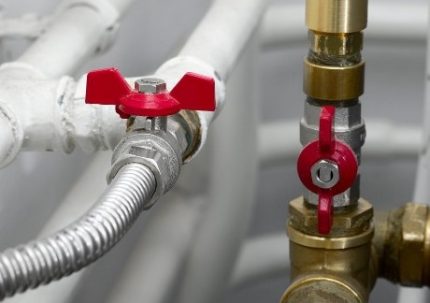
After that, you can open the valve in the basement to resume water supply, and then check the tightness of the connections made.
Pipe installation and instrument connection
Pipes are laid from the riser. Their installation takes place in parallel, fasteners are carried out at several points so that there is no sagging. The connection of elements is carried out using fasteners (fittings of various types), and by solderingfor which a soldering iron is required.
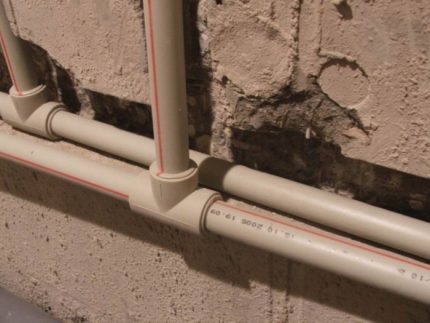
In the area where the sink, shower, bathtub, and washing machine are located, branches are cut off by ball valves. Cold water is supplied to the toilet, cold and hot to all other appliances. To the ends of the pipes mounted cranes, which must be in a closed state.
If you plan to mask cold water pipes behind a false wall, they must be insulated with foamed polyethylene to get rid of the condensate.
To install the mixer above the bath, it is necessary to gouge the wall to deepen a fragment of pipes into it. A special film and flanges fixed at some distance are placed at the ends, which must be fixed at the same level with the wall surface, with a small tolerance on the thickness of the finishing material.

Due to the elasticity of the material, polypropylene pipes can be slightly bent, so it is possible to reduce the number of fittings used in laying the system. This is important not only for saving money: in a smoothly laid water supply, the likelihood of blockages caused by deposits is reduced.
In order to prevent a break in communications from water hammer, a compensation loop must be provided in the system.
Replacing sewer pipes
An important and crucial step is the replacement of old sewer pipes, which are often in poor condition due to corrosion and rotten seals. The new plumbing system will improve drainage and eliminate odors and leaks.
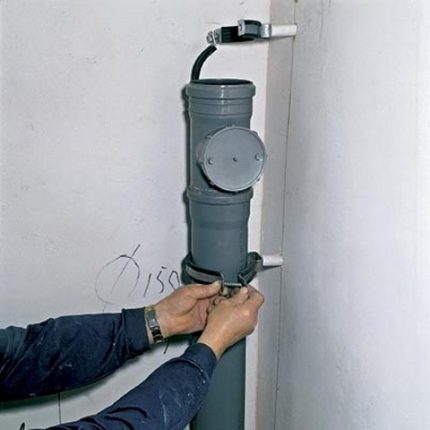
To replace sewer pipes, the following algorithm is used:
- The places where plumbing fixtures will be installed are indicated.
- Given the dimensions of the sanitary ware, accurate measurements are made to determine the drain points.
- A sketch is drawn with an approximate scheme of the sewer system, where the branching of communications, the installation site of the revisions, and the parameters of the elements are indicated.
- According to the drawing, calculations are made, according to the results of which materials are purchased.
- With the help of a grinder, the old elements are dismantled.
- If you plan to replace the riser, it is necessary to dock its parts using special adapters. This work will have to be done in the apartments of residents located above and below after prior approval.
- Having disassembled the old communications, you can proceed with the installation of the system from new pipes, making fixtures so that the elements are located at an angle of about 5about. It is advisable to reduce the number of unnecessary bends, in which deposits often accumulate, and if necessary, make them as smooth as possible.
In conclusion, communications through the wall are diverted from the kitchen to the bathtub. After that, you need to connect all the pipelines, connecting them together. Upon completion of the test, open sections of pipelines are closed in any of the popular ways.
Checking the results of work
The wiring of new water and sewer pipes must be completed by inspection. To do this, cold and hot water is turned on alternately, the joints are carefully inspected.
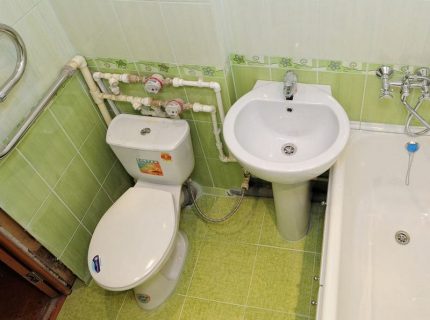
Large leaks are detected by eye, small leaks can be detected with a paper towel, which wipes a dubious section of the pipe.
All malfunctions should be eliminated by disassembling the structure and re-folding it or replacing the defective fragment.
Conclusions and useful video on the topic
You can visually see the process of laying pipes on the presented video.
The process of replacing the water supply and sewerage in the bathroom is quite within the power of a master who has some skills in working with plastic pipes. Carefully following the instructions and using high-quality materials, such operations can be completed quickly enough.
Newly conducted communications made of modern plastic will serve reliably over a long period of time.
Want to talk about how you personally changed the pipes in the bathroom? It is possible that you know the technological subtleties that will be useful to site visitors. Please write comments in the block below, post photos and ask questions on the topic.

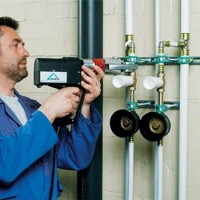 How to replace the water risers in the apartment: a step-by-step guide
How to replace the water risers in the apartment: a step-by-step guide  Piping in the bathroom: analysis of hidden and open piping schemes
Piping in the bathroom: analysis of hidden and open piping schemes 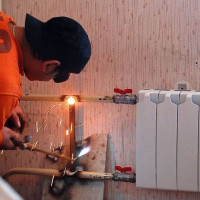 Replacing gas-fired heating batteries: a review of technology
Replacing gas-fired heating batteries: a review of technology  Replacing pipes in the toilet from A to Z: design, selection of building materials, installation work + error analysis
Replacing pipes in the toilet from A to Z: design, selection of building materials, installation work + error analysis  Pressure testing of metal-plastic pipes: the order and nuances of the work
Pressure testing of metal-plastic pipes: the order and nuances of the work  We make a box for pipes in the bathroom: step-by-step installation instructions
We make a box for pipes in the bathroom: step-by-step installation instructions  How much does it cost to connect gas to a private house: the price of organizing gas supply
How much does it cost to connect gas to a private house: the price of organizing gas supply  The best washing machines with dryer: model rating and customer tips
The best washing machines with dryer: model rating and customer tips  What is the color temperature of light and the nuances of choosing the temperature of the lamps to suit your needs
What is the color temperature of light and the nuances of choosing the temperature of the lamps to suit your needs  Replacement of a geyser in an apartment: replacement paperwork + basic norms and requirements
Replacement of a geyser in an apartment: replacement paperwork + basic norms and requirements
The best option for plumbing is polypropylene. It is inexpensive, it is sold everywhere, it is easy to work with it. No need to think about the length of the pipes - cut off how much you need and do the cutting in the right place. Connections are also elementary. The problem is only fixing to the wall, for this you need to drill holes, here success depends on the experience and the material from which the house is built.
The most difficult thing in replacing the pipes was to agree with the neighbors above and below. I had to cut the thread precisely at them, so that polypropylene, and not rotten piece of iron, stood in the ceiling. In general, many negotiations were worth the nerves. In addition to all the troubles, the risers were very close to the wall, and the plugs, and even more so, twisting the handle, had to be energized by the pipe. But he managed it, I can’t believe it myself!
And the wiring in the bathroom is already easier, because you work at home, no one breathes in the back.
The article is timely for me. Thank.
Today I’ll straighten out this sharash company and take care of it myself. He invited plumbers to repair the bathroom, and they, bastards, have been thumping for a week.
At whose expense plump? 🙂
Hello 🙂 I share your indignation 🙂 The only advice, after all, if you live in an apartment and plumbing from the Criminal Code, file a complaint to the name of the chief of the Criminal Code and, in case of self-repair, agree everything beforehand.